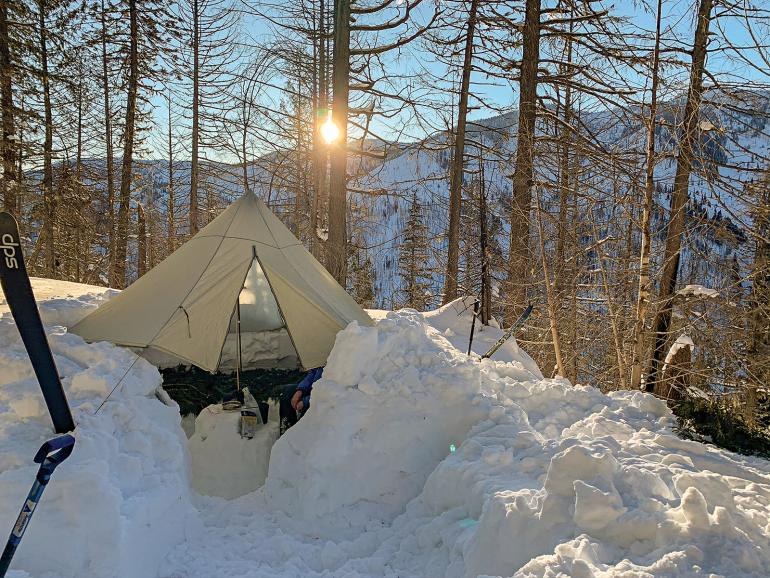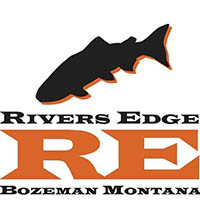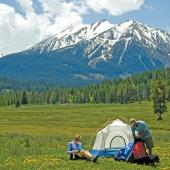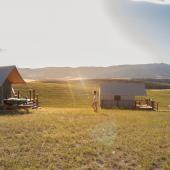Out Cold
Winter camping, with and without a tent.
When most people think of camping, they picture warm summer nights and grilled food around a campfire. That’s what I thought of, too, until my first winter-camping experience. I was 20 years old, and a new friend wanted to test how tough I was by asking me to go camping in December. I didn’t want to seem like a wimp, so I agreed, and prepared to spend an evening being very cold.
My friend didn’t own an arctic tent, but he assured me that he had all the proper gear and that we’d be sufficiently warm. To demonstrate, he did a dry-run of our campsite in his basement. He had three blue tarps, four poles, and some rope. He assembled that into a tent structure, piling pillows around the edges to simulate the snow we would pack on top. We crawled inside. It was surprisingly warm, and we hadn’t even put any insulation between us and the unfinished basement floor. With the rubber mats we planned to put under our sleeping bags and my friend’s wood-burning camp stove, I figured we’d be okay.
When it comes to camping, it’s not what you spend on your gear that matters, it’s knowing how to use it.
On the day of our trip, I didn’t get off work until six in the evening, so it was already dark as we drove out to the camping area. We weren’t worried, because we already knew how to set up our shelter. We carried everything out of his hatchback to our campsite, then shoveled a ten-foot-wide circular area clear of snow. His headlights provided illumination as we quickly worked to get our shelter up.
We anchored the poles, arranged the tarps over the poles, and tied them in place. I laid out the rubber mats and sleeping bags while my friend built a fire, and then I worked on insulating the exterior of the tarp tent. We piled snow around the bottom edges, sealing all the warm air inside our shelter. My friend positioned his camp stove in front of the tent’s entrance so heat would radiate inside, but far enough away to avoid melting the tarps. He made an arc of firewood behind it to reflect the heat toward us. By the time we were done piling snow and stacking firewood, it was close to 50 degrees inside. We cooked steak and rice on the camp stove, and were toasty as we enjoyed our feast.
Every few hours throughout the night, one of us would wake up cold and add more wood to the camp stove, but our makeshift tent was otherwise a comfortable experience. Morning dawned crisp and clear, and going back to work after that outing was a drudgery. Just a few weeks later, I called my friend and asked if he’d like to go camping again.
This time, we decided to bring a military-surplus arctic tent, so I did some shopping around. Soon enough, and for a few hundred dollars, a ten-man tent was mine. I spread it out in the back yard to examine it and found a few holes in need of patching. Once that task was complete, my friend and I were ready to put the new tent to the test. We loaded up his car and headed out, this time for the entire weekend.
Nothing will ever be as perfect for a trip as what you can perfectly tailor to the conditions yourself.
Putting up a ten-man tent with two people is a chore. It’s bulky, heavy, and designed to be assembled by at least a party of four. Because it was military surplus, it didn’t come with instructions. When I’d examined it in my yard, I was only checking the quality of the canvas. It wasn’t until we were 12 miles down a dirt road and trying to put up the tent that I realized it was missing some key components, such as the pin that held together the two pieces of the center support pole. We improvised with a stick and some electrical tape, and finally got the tent up.
Our first night was uncomfortable, to say the least. In the early evening, it was way too hot inside, so we rolled up the side panels to improve ventilation. Then, in the night, it got way too cold, even with the panels down. The wind came through the seams of the decades-old tent, chilling us to the bone—even with the camp stove inside the tent with us. There was a vent where the smoke from the camp stove was supposed to exit, but the wind kept blowing it back inside, suffocating us. We got very little sleep.
In the morning, we took everything out, dismantled the tent, and tried to put it back up in a way that would better withstand the wind. We realized we hadn’t had the sides fully extended, causing slack and allowing the wind to get in. Once we got the tent set up properly, our second night was much warmer, but we still couldn’t resolve the issue of the smoke coming in every time the wind blew.
It took several more trips and a little customization before that tent finally became what I had initially imagined. After nearly two years, I finally had a winter-camping trip as comfortable as that first night with my friend. Whether I should have bought the tent isn’t the question. It has more than proved its value to me. But nothing will ever be as perfect for a trip as what you can perfectly tailor to the conditions yourself. I never would have guessed that 60 dollars of tarps and poles would provide better shelter from December weather than an arctic tent costing five times that much.
But on that first trip with the arctic tent, I learned a valuable lesson: when it comes to camping, it’s not what you spend on your gear that matters, it’s knowing how to use it.



























